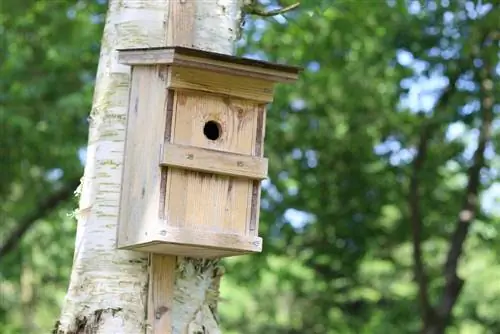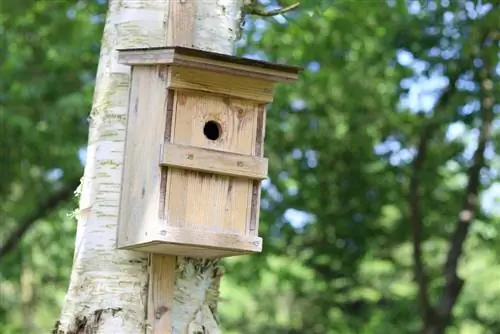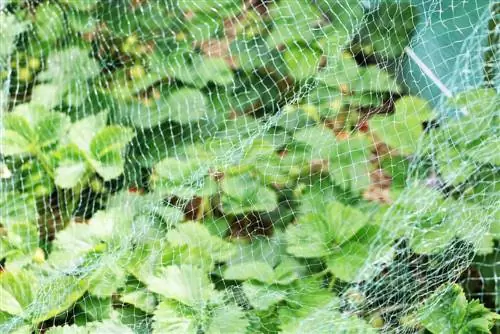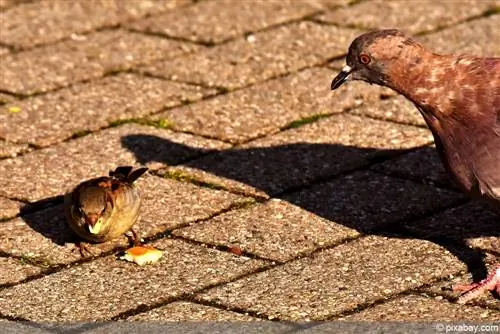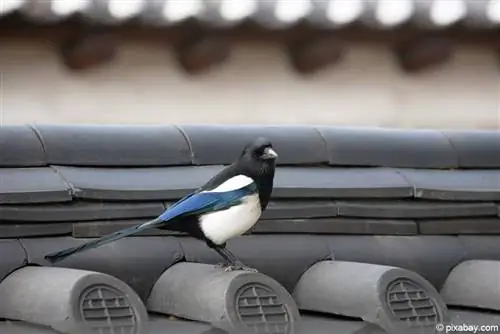- Author admin [email protected].
- Public 2023-12-17 03:39.
- Last modified 2025-01-24 12:45.
Birdhouses and nesting boxes in the garden make it easier for birds to find food and a place to breed. But many gardens are not only a bird paradise, but also a cat area. Although cats have been kept as pets in our latitudes for around 900 years, they still have the hunting instincts of wild predators. Birds are popular prey for cats, so they need to be protected from you. Here you can find out what you can do to ensure that cats have no chance of reaching the birds in the birdhouse or nesting box.
Protect birds from cats in the feeder
So that birds who eat grains from a birdhouse in the garden can feel safe, bird lovers strive to ensure that the feeding place is out of reach of cats. If this isn't 100 percent possible, then they at least want to ensure that the birds have a good opportunity to notice approaching cats in time to get themselves to safety.
Secure birdhouses and make them out of reach of cats
Cats are very agile, can climb well and can easily overcome a height difference of 2 meters when jumping. The following measures can still be used to protect birds that are getting food from them:
- Place the bird house over two meters high on a post or secure it in a tree and use a ladder for feeding
- It is best to use a smooth metal or plastic pole as a post.
- If the surface of the stand provides support for the cat, or the birdhouse is in a tree, a cat repellent belt can prevent the cat from climbing up.
- Wrapping poles and tree trunks with long prickly blackberry vines can also deter cats from climbing.
- A smooth plastic or sheet metal sleeve wrapped around the bark, which is about 80 centimeters wide, is also difficult for a cat to overcome.
Tip:
If it is not your own cats, but cats from the neighborhood that are making the garden unsafe, higher-up building windows or higher-up balconies that other cats cannot reach from inside are safe places for a bird house. However, it is assumed that there are no trellises or other climbing aids for cats on the house wall.
Helping birds in the feeder to notice approaching cats in good time
Cats like to use the cover of bushes to sneak up on birdhouses. Therefore, feeders and birdbaths that do not otherwise provide adequate protection from cats should be placed far away from bushes. If you don't set up a bird house or a bird bath at a height of more than two meters, but do place it on an open lawn, you are still providing birds with valuable help in protecting themselves from cats.
The bird bath or feeder should be at least 2 meters away from the nearest bushes. This forces the cat to approach the feeding place without cover. Birds have the chance to see the attacker early enough to fly away in time.
Protect nesting boxes from cats
Unlike birdhouses, nesting boxes are usually not located on open lawns, but are located near bushes or attached to trees. Their branches support young birds in their first attempts to fly. In addition, parent birds do not need to travel very far from the nesting box to look for food, as they find more lice, flying insects and caterpillars on the leaves and flowers of trees and bushes than on a mown lawn.
While some ways to protect birds from cats in nesting boxes differ from those in birdhouses, others are identical. Unlike birdhouses, nesting boxes can be protected from the entrance hole by a porch. Thoughtfully constructed, it can make it impossible for cats' paws to access the nest box inhabitants. However, it should be noted that the porch must not prevent the birds from feeding their young.
If you don't want to use a porch, you can ensure that the nest inside the nesting box is so deep below the entrance hole that a cat that sticks its paw through cannot reach it. To ensure this, it is often enough to always remove old nests from the box so that the new nest is not built over it and is higher.
Nest boxes on trees

Nesting boxes attached to the branches or trunks of trees can be protected like birdhouses with special cat repellent belts, which are available from specialist retailers. In addition, the following self-made aids make it difficult for cats to access the nesting box via the trunk:
- Lumber made of thorny bushes tied man-high around the tree with branch ends pointing downwards
- a smooth cuff made of wood or plastic placed around the tree, which starts at about 2 meters high and has a width of about 80 centimeters
Nest boxes on hedges
If birds nest in or near hedges, the bushes can be designed so that cats cannot get into them, but the birds have good opportunities to hide and forage. Planting the following shrubs transforms a bush or hedge into a prickly, impenetrable thicket that cats avoid.
- Hawthorn (Crataegus)
- Sea buckthorn (Hippophae rhamnoides)
- Blackthorn (Prunus spinosa)
- Pfaffenhütchen (Euonymus europaeus)
- Hedge rose (Rosa corymbifera),
- Dog rose (Rosa canina)
- Dogwood (Cornus)
- Blackberry bush (Rubus)
Tip:
Although cats are typical carnivores, they sometimes also chew parts of plants. However, some plants are poisonous to cats, including ivy. That's why some cats instinctively avoid nest boxes and birdhouses surrounded by ivy vines. It's all about trying.
A home remedy to keep cats away from nesting boxes on bushes are non-toxic plants whose smells the four-legged friends don't like.
This includes
- Lavender (Lavandula angustifolia)
- Rue (Ruta graveolens)
- Large-rooted cranesbill (Geranium macrorrhizum)
- Italian Strawflower (Helichrysum italicum)
- burning bush (Dictamnus)
- Lemon bush (Aloysia triphylla)
Since every cat has a very individual taste, the effectiveness of the plants can vary greatly. The repelling effect is not the same for all cats.
In general:
The more numerous the plants are, the stronger the effect. Cats especially avoid plants with a citrus smell and plants with a menthol smell. The animals often look for another hunting ground.
The cat repellent belt
A cat repellent belt is considered effective protection from cats for birds that use nesting boxes or birdhouses in trees. The cat repellent belt consists of individual metal links. On their upper and lower edges there are long, outwardly protruding thorns made of metal wire, the tips of which have plastic caps so that cats do not injure themselves on them.
The size of the belt can be adjusted to the circumference of the trunk by removing individual links. If the tree grows quickly and becomes wider, the limbs can be reinserted to prevent the belt from growing into the bark and trunk. Smaller cat repellent belts for trunk circumferences of up to 70 centimeters and larger cat repellent belts for trees with trunk circumferences of up to 115 centimeters are available from specialist retailers.
The cat belt must be placed around the tree trunk at a height of about 2.5 meters so that cats cannot simply jump over it from the ground.
Very slim and agile cats sometimes manage to squeeze through the metal wire thorns of the cat belt and climb the trunk despite the barrier. In such cases, the following countermeasures can prevent the cats from overcoming the cat belt.
- funnel-shaped wrapping of the belt with rabbit wire
- Connecting the thorns with floral wire
- tie thin branches between the thorns
- Tie pine branches between the thorns
- Weave blackberry vines between the individual thorns
- Push the pond liner between both rows of thorns
- lay a fine wire mesh net over the thorns
Stop domestic cats from hunting birds
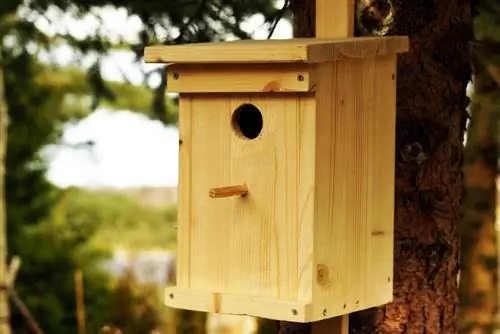
It's hard to break a cat's habit of hunting. Even if she is fed regularly, she wants to satisfy her natural hunting instincts. However, a full house cat does not eat all of its prey. Sometimes she just lives out her play instinct.
Provide variety and exercise
Since it is not important for the house cat what the prey is, if you want to stop the cat from hunting birds, it can be helpful to play with it and have it grab a ball of wool, for example allow. The cat grabs anything that moves. Once she has satisfied her hunting instinct in play, her desire to hunt for birds in the garden disappears.
Keep cat in the house
Contrary to what is often assumed, house cats do not necessarily have to be outdoor cats. Cats that live exclusively indoors feel just as comfortable and are often even he althier. If you keep a cat that only lives indoors, you don't have to worry about the birds outside in the garden. Since young birds cannot yet defend themselves against hunting cats, domestic cats should stay indoors at least during the months of April, May and June, because at this time young birds often want to make their first attempts to fly.
The Cat Bell
A cat bell is a small metal bell that is placed around the cat using a collar. By sounding, it alerts birds to the approaching cat so that they can fly away in time.
Advantages
- Cat bells can reduce the number of birds captured by up to 50 percent.
- For many cats, the bell is not a problem.
Whether the cat gets used to the bell or feels disturbed by its constant ringing varies from animal to animal.
Disadvantages
The bells do not protect the helpless offspring of birds that cannot yet fly. Hearing the bell ringing as a warning is of no use to him. Cats wearing a cat bell run the risk of the collar getting caught on something, squeezing parts of their body or even strangling themselves.
Tip:
When buying the cat bell, make sure that the collar does not pose a danger to the cat. An elasticated collar is a good choice. The cat may be able to remove this itself in difficult situations. We also recommend straps that open on their own when there is great tension.
In general, it is better to effectively entice cats to access nesting boxes and birdhouses through appropriate measures than to make their lives unnecessarily difficult. One of the advantages of barriers and unwanted plants is that they not only work against cats kept as pets, but also against stray cats and other nest predators such as martens or squirrels.

